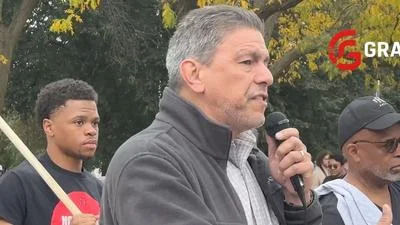Michael Barbier, Councilman, East District | City of Wheaton Website
Michael Barbier, Councilman, East District | City of Wheaton Website
City of Wheaton City Council Planning Sessions met July 8
Here are the minutes provided by the council:
I. Call to Order
The Wheaton City Council Planning Session was called to order at 7:00 p.m. by Mayor Suess. The following were:
Physically Present: Mayor Suess
Councilman Barbier
Councilman Brown
Councilwoman Bray-Parker
Councilman Clousing
Councilwoman Robbins
Councilman Weller
City Staff Present: Michael G. Dzugan, City Manager
John M. Duguay, Assistant City Manager
Joseph Tebrugge, Director of Engineering
Robert Brill, Fire Chief
Sonia Zala, Traffic Engineer
Halie Cardinal, Public Relations Coordinator
II. Approval of Planning Session Minutes – June 10, 2024
The City Council approved the June 10, 2024, City Council Planning Session Minutes.
III. Dynamic Speed Signs
The City of Wheaton Engineering Department summarized its review into the possible use of permanent Dynamic Speed Feedback Signs (DSFS) as a traffic calming tool to address areas where drivers consistently exceed the speed limit. The Engineering Department recommends that if DSFS are implemented, the City develop a policy on when and where they should be installed to ensure uniformity.
Traffic Engineer Zala reviewed DSFS, which are traffic control devices placed below regular speed limit signs containing an embedded radar that alerts drivers to their vehicle’s speed.
In response to a Council question, Traffic Engineer Zala stated that the City currently has temporary DSFS, which are battery-powered, whereas permanent DSFS are solar-powered and cost approximately $3,000-$4,000 per unit.
Traffic Engineer Zala reviewed the results of Federal Highway Administration studies on the long-term effects of permanent DSFS placement. This data showed that DSFS effectively reduced the 85th percentile speed (the speed at or below which 85% of drivers will operate with open roads and favorable conditions) by approximately 5 mph. Traffic Engineer Zala noted that a 5 mph reduction of speed can significantly reduce the risk of severe injury when a pedestrian is struck by a vehicle.
Staff recommended that the following criteria be met for placement of DSFS: the roadway is classified as a collector or arterial; the roadway has no more than one through lane in each direction; the average 85th percentile speed limit is consistently 10 mph or more over the posted speed limit; and the location of speeding spans at least 800 feet.
Staff conducted a speed analysis of the City utilizing Urban SDK, a data analytics and visualization software that analyzed traffic speeds and volume ranges. The software identified 10 streets where the 85th percentile speed was 10 mph or more over the posted speed limit. The analysis identified two roadways as the top concerning areas based on the outlined criteria. These areas are College Avenue between Blanchard and Glencoe (consistently 16 mph over the speed limit), and Manchester Road between Knollwood and Gables (consistently 13 mph over the speed limit). Staff recommended conducting a pilot program for the DSFS placed on these two roadways.
Staff recommend purchasing four DSFS with two for College Avenue and two for Manchester Road, at a total cost of approximately $16,000. After the installation, staff plan to utilize Urban SDK to analyze trends after one month, two months, six months, and one year. Based on the data, staff will provide future recommendations about the placement of additional permanent DSFS.
Council members expressed an interest in DSFS criteria also considering a location’s history of vehicle crashes, pedestrian volume, and residential streets of concern. Council members discussed the importance of evaluating the data collected from the pilot program to determine if additional DSFS should be installed in other areas of the City.
In response to Council questions, Traffic Engineer Zala stated that the goal of the pilot program is to evaluate if the DSFS are effective in causing speed reduction. City Manager Dzugan stated that the intention of installing this permanent signage is to reduce speeding within the City and serve as a traffic calming tool.
In response to a Council question, Traffic Engineer Zala stated that the City has no jurisdiction over Roosevelt Road and Butterfield Road and can only place DSFS equipment on local roadways.
The Council expressed interest in conducting a Planning Session dedicated to reviewing overall speeding in the City. The Council directed staff to move forward with the pilot program but to reevaluate the two pilot streets based on speeding and pedestrian volume.
IV. Ambulance Service Fees
Fire Chief Brill provided background on the recommended new methodology for calculating ambulance service fees in a way that is consistent with industry best practices and assists the City in better capturing costs related to providing emergency medical services. This methodology is based on the Centers for Medicare and Medicaid Services' cost report (EMT Integrated Disclosure and Medicaid Cost Report). He noted that the City participates in the Ground Emergency Medical Transportation (GEMT) program, which is a federally funded initiative that provides supplemental funding to publicly operated ambulance service providers registered with Medicaid. This information was originally discussed at the June 10, 2024 City Council Planning Session.
Fire Chief Brill stated that under the proposed cost recovery formula, the City would include all fees associated with an ambulance service. The major difference between the proposed and current methodologies for calculating the service fee is the inclusion of the City’s costs for firefighters who respond to EMS calls. He stated that firefighters respond with paramedics on approximately 51% of all EMS requests for service.
Chief Brill stated that in 2022, the average cost for an ambulance service was approximately $2,500. In 2023 the cost was $2,910, and 2024 is projected to have the same cost. He stated that adopting the new methodology will result in additional revenue due to the increased service fees. This could result in additional revenue of $1.3 million per year.
After reviewing the data, staff recommend that the proposed rate be the same for all EMS services (BLS, ALS1, ALS2), regardless of residency status. Staff also recommend implementing balance billing for nonresidents only, which is the practice of invoicing ambulance users for any remaining charges after final payment has been received from third-party insurance providers or payors. Residents would not be balance billed.
In response to Council questions, Fire Chief Brill stated that the commercial insurance reimbursement rate for ALS1 service calls is approximately 70-80% for residents and non-residents. He stated that the significant increase in the City’s ambulance service fee is due to the industry’s shift to this new methodology, based on the GEMT program.
The Council agreed to move forward with implementing the proposed service fee methodology and resulting fee increase. City Manager Dzugan stated that staff will prepare an ordinance for first reading to be placed on the August 5 City Council Agenda.
V. Public Comment
There were no public comments.
VI. City Council/Staff Comments
Councilman Barbier thanked community partners, such as the Wheaton Park District, for executing the Independence Day Parade.
VII. Adjournment
The meeting was adjourned at 7:56 p.m.
https://www.wheaton.il.us/AgendaCenter/ViewFile/Item/11839?fileID=16697






 Alerts Sign-up
Alerts Sign-up